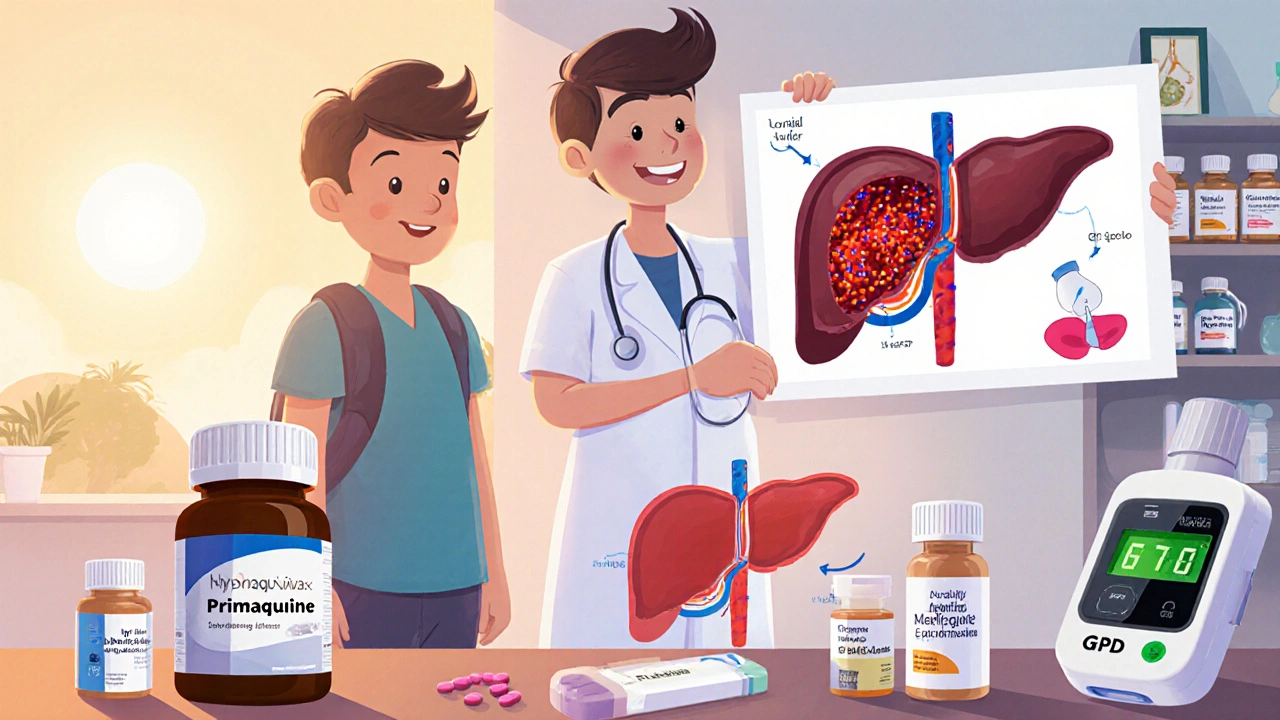Antimalarial Selection Tool
Select Your Parameters
Recommended Antimalarial
Quick Takeaways
- Primaquine excels at eliminating dormant liver stages of Plasmodium vivax and Plasmodium ovale.
- Key alternatives (chloroquine, mefloquine, atovaquone‑proguanil, tafenoquine) differ in dosing frequency, half‑life, and safety constraints.
- G6PD deficiency is the single biggest contraindication for all 8‑aminoquinolines, including Primaquine and tafenoquine.
- Cost varies widely: generic Primaquine is cheap, whereas tafenoquine can be 10‑20× more expensive.
- Choosing the right drug depends on malaria species, travel duration, patient genetics, and local resistance patterns.
Why Primaquine Still Matters
When treating malaria, Primaquine is an 8‑aminoquinoline antimalarial used primarily for radical cure of Plasmodium vivax and Plasmodium ovale hypnozoites. Its unique ability to clear dormant liver forms prevents relapses, a feature no other commonly prescribed antimalarial offers.
For travelers heading to endemic zones, clinicians often ask: “Is Primaquine the best choice, or should I consider something else?” The answer hinges on three pillars - efficacy against the target species, safety for the individual, and practicality of the dosing regimen.
Mechanism of Action and Pharmacokinetics
Primaquine works by generating reactive oxygen species that damage the parasite’s mitochondrial DNA. This oxidative burst preferentially kills the non‑replicating hypnozoite stage.
Key pharmacokinetic facts (all values from WHO 2023 guidelines):
- Absorption: Rapid, peak plasma at 2‑3 hours.
- Half‑life: Approximately 6 hours (shorter than most alternatives).
- Metabolism: Primarily by CYP2D6; poor metabolizers may see reduced efficacy.
- Excretion: Renal, unchanged fraction < 5%.
The short half‑life means daily dosing is required for the full course (typically 14 days for radical cure).
Safety Profile - The G6PD Story
All 8‑aminoquinolines share a risk of hemolytic anemia in patients with glucose‑6‑phosphate dehydrogenase (G6PD) deficiency. The severity correlates with the drug’s oxidative potential.
Primaquine’s hemolysis risk is moderate; a single 0.5 g dose for radical cure can trigger a 5‑15% drop in hemoglobin in G6PD‑deficient males. Women with intermediate activity may experience milder drops but still need monitoring.
Because of this, a quantitative G6PD test (e.g., fluorescent spot test or point‑of‑care biosensor) is recommended before any 8‑aminoquinoline prescription.
Alternative Antimalarials - Who’s Who?
Below is a quick snapshot of the most common alternatives. Each entry includes a brief definition wrapped in microdata for first‑time readers.
Chloroquine is a 4‑aminoquinoline effective against P. falciparum in regions without resistance. It’s taken once weekly for prophylaxis or a 3‑day course for treatment.
Mefloquine is a quinoline‑methanol used for both prophylaxis and treatment, noted for its long half‑life (≈20 days). Dosing is once weekly, but neuropsychiatric side effects limit its use.
Atovaquone‑proguanil (Malarone) is a combination that interferes with mitochondrial electron transport and folate synthesis, respectively. It’s taken daily, works against most P. falciparum strains, and is well tolerated.
Tafenoquine is an 8‑aminoquinoline approved for single‑dose radical cure and prophylaxis. Its half‑life exceeds 14 days, making weekly dosing possible, but it shares the G6PD‑deficiency risk.
Side‑by‑Side Comparison
| Attribute | Primaquine | Chloroquine | Mefloquine | Atovaquone‑proguanil | Tafenoquine |
|---|---|---|---|---|---|
| Primary Indication | Radical cure of P. vivax/o. ovale | Treatment & prophylaxis of chloroquine‑sensitive P. falciparum | Prophylaxis & treatment of P. falciparum | Prophylaxis & treatment of multidrug‑resistant P. falciparum | Single‑dose radical cure & prophylaxis |
| Dosing Regimen | 0.5 g daily for 14 days (radical cure) | 300 mg base weekly (prophylaxis) or 600 mg base over 3 days (treatment) | 250 mg weekly (prophylaxis) or 1250 mg single dose (treatment) | 250 mg/100 mg daily (prophylaxis) or 4‑day treatment | 300 mg single dose (radical cure) or 200 mg weekly (prophylaxis) |
| Half‑Life | ≈6 hours | ≈1‑2 days | ≈20 days | ≈2‑3 days | ≈14‑15 days |
| Key Contra‑indications | G6PD deficiency, pregnancy (first trimester) | Retinal disease, G6PD deficiency (rare) | History of neuropsychiatric illness, G6PD deficiency | Severe renal impairment, hypersensitivity | G6PD deficiency, pregnancy (any trimester) |
| Common Side Effects | GI upset, methemoglobinemia, hemolysis (G6PD) | Pruritus, mild GI upset | Dizziness, vivid dreams, anxiety | Headache, abdominal pain, taste alteration | GI upset, mild hemolysis, dizziness |
| Cost (US, generic) | ≈$0.10 / tablet | ≈$0.15 / tablet | ≈$0.60 / tablet | ≈$4.00 / tablet | ≈$25 / dose (brand only) |
When to Choose Primaquine Over Alternatives
Consider Primaquine if:
- You need to eradicate hypnozoites after a confirmed P. vivax or P. ovale infection.
- The patient has normal G6PD activity (verified by quantitative test).
- Cost is a limiting factor - Primaquine remains the cheapest radical‑cure option.
- You can ensure daily adherence for two weeks.
If any of those conditions fail, one of the alternatives may be safer or more convenient.

Choosing an Alternative - Decision Guide
- Species & Resistance: For chloroquine‑sensitive P. falciparum, chloroquine is cheap and effective. In areas with high resistance, favor atovaquone‑proguanil or mefloquine.
- Patient Genetics: G6PD deficiency pushes you away from primaquine and tafenoquine. CYP2D6 poor metabolizers may see reduced primaquine efficacy; consider atovaquone‑proguanil instead.
- Side‑Effect Tolerance: If a patient has a history of depression or severe anxiety, avoid mefloquine. For patients who dislike daily dosing, tafenoquine’s single‑dose regimen is appealing despite higher price.
- Pregnancy: Primaquine is contraindicated in the first trimester; mefloquine is the most studied antimalarial for later pregnancy stages, though guidance varies by country.
- Cost Constraints: In low‑resource settings, chloroquine (if still effective) and primaquine are the most affordable.
Practical Tips for Clinicians
- Always order a quantitative G6PD assay before prescribing any 8‑aminoquinoline.
- Check local resistance data from the WHO malaria map; resistance patterns shift annually.
- Document patient weight to calculate exact mg/kg dosing - under‑dosing can lead to relapse.
- Provide written adherence aids (calendar stickers, SMS reminders) for the 14‑day primaquine course.
- Educate patients about warning signs of hemolysis: dark urine, sudden fatigue, shortness of breath.
Frequently Asked Questions
Can I take primaquine if I’m pregnant?
Primaquine is generally avoided in the first trimester because animal studies show fetal toxicity. In the second and third trimesters some guidelines allow use if the benefit outweighs risk, but most clinicians prefer alternatives like mefloquine for prophylaxis during pregnancy.
How does tafenoquine differ from primaquine?
Tafenoquine offers a single‑dose radical cure (300 mg) and weekly prophylaxis, thanks to its long half‑life. However, its safety profile mirrors primaquine - G6PD testing is mandatory, and it’s markedly more expensive.
What is the role of CYP2D6 in primaquine efficacy?
CYP2D6 metabolizes primaquine into active metabolites that attack hypnozoites. Patients who are CYP2D6 poor metabolizers may experience higher relapse rates, so clinicians sometimes choose atovaquone‑proguanil for them.
Is chloroquine still useful in 2025?
In parts of Southeast Asia and sub‑Saharan Africa, chloroquine resistance is pervasive, rendering it ineffective against P. falciparum. However, in Central America and parts of Oceania it remains a cheap, reliable option for P. vivax and chloroquine‑sensitive strains.
How should I monitor a patient on primaquine for hemolysis?
Baseline hemoglobin and bilirubin are taken before starting therapy. Follow‑up labs on day 3 and day 7 detect early drops. If hemoglobin falls >2 g/dL or the patient reports dark urine, stop primaquine immediately and provide supportive care.
Bottom Line
Primaquine remains the gold standard for eliminating malaria relapses, but its use is gated by G6PD status and daily adherence. Alternatives fill the gaps-chloroquine for cheap, short‑term prophylaxis where resistance is low; mefloquine for weekly dosing but with neuro‑psychiatric caveats; atovaquone‑proguanil for broad‑spectrum coverage; and tafenoquine for single‑dose convenience at a premium price.
By aligning the patient’s biology, travel itinerary, and budget with the strengths and limits outlined above, you can pick the antimalarial that delivers protection without unexpected side effects.



Great summary! Primaquine’s low price and hypnozoite‑killing power make it a frontline choice for travelers, especially when G6PD testing is clear.
Indeed, the pharmacokinetic profile-rapid absorption, ~6‑hour half‑life, and CYP2D6 dependence-means clinicians must verify metabolic status to avoid sub‑therapeutic exposure.
When we consider malaria not merely as a pathogen but as a reminder of humanity’s vulnerability, the decision to eradicate latent liver forms becomes an ethical imperative, urging us to balance risk and benefit with humility.
While the table is informative, it glosses over the real‑world complications of adherence to a 14‑day regimen; many patients in endemic regions simply cannot guarantee daily intake, rendering the theoretical superiority of primaquine moot.
Excellent overview! 🌍 The inclusion of cost comparisons helps clinicians in low‑resource settings make evidence‑based choices. 📊